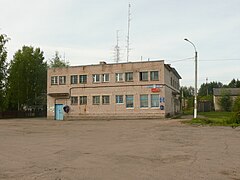Batezki
| settlement
Batezki
Батецкий
|
||||||||||||||||||||||||||||||
|
||||||||||||||||||||||||||||||
|
||||||||||||||||||||||||||||||
Batezki ( Russian Бате́цкий ) is a settlement (possjolok) in the Novgorod Oblast in Russia with 2258 inhabitants (as of October 14, 2010).
geography
The place is about 60 km as the crow flies west-northwest of the Veliky Novgorod Oblast Administrative Center and about 10 km from the border with Leningrad Oblast on the right bank of the Udraika, which flows into the Luga about 15 km west of the right .
Batezki is the administrative center of the Rajons Batezki and seat of the rural community Batezkioje selskoje posselenije, are among the 52 other villages. Of these, only one has more than 100 inhabitants (Gorodnja 6 km northwest, 273 inhabitants), 21 have more than 10 inhabitants, 23 under 10 and seven have no permanent residents (as of 2010).
history
The settlement dates back to the village of Batezko, which was first mentioned in a document in the 16th century, a good four kilometers to the east (today part of the municipality, 25 inhabitants in 2010). From the beginning of the 1890s, a railway line from Saint Petersburg via Dno and Novosokolniki to Vitebsk (now in Belarus ) passed there, and a settlement was built at the future railway station named after the village from 1892. The Batezkaya station began regular operations on the entire line in 1903. The station and settlement were on the territory of the Volost Gorodnja in Ujesd Luga of the Saint Petersburg governorate (from 1914 Petrograd governorate , from 1924 Leningrad governorate ), not far from the border with Ujesd Novgorod of the Novgorod governorate .
In 1916/1917 another railway line from Novgorod to Batezkaya was built and construction of the continuation in a westerly direction to Luga began; this part only went into operation in 1922/1923 after the end of the Russian Civil War . The settlement with the thus incurred railway junction was in the 1920s, the most important town in the area and thus on August 1, 1927 of a seat named after her Rajons the newly Leningrad Oblast (to 1930 held by the okrugs Luga).
During the Second World War , Batezki was captured by the German Wehrmacht from August 16 to 18, 1941 and recaptured by the Red Army on February 11, 1944 after five days of fighting over the train station . On July 5, 1944, the Rajon became part of the newly established Novgorod Oblast.
From February 1, 1963 to December 31, 1965, the Rajon was temporarily dissolved and its territory joined the Novgorodsky Rajon.
Population development
| year | Residents |
|---|---|
| 1939 | 569 |
| 1959 | 1347 |
| 1970 | 1976 |
| 1979 | 2239 |
| 1989 | 2473 |
| 2002 | 2275 |
| 2010 | 2258 |
Note: census data
traffic
In the station Batezkaja the routes of St. Petersburg (cross vitebsky railway station ) to Wizebsk in Belarus (kilometer 147) and of Luga according Novgorod (kilometer 35).
The regional road 49A-04 from Veliky Novgorod runs just under three kilometers north of Batezki on the federal trunk road M10 Rossija to the border of Leningrad Oblast, from there as 41K-141 to Luga on the federal trunk road R23 . The 41K-2122 leads through the settlement and initially along the railway line to the south to 49K-03 near Schimsk .
Web links
- Rural Municipality of Batezkoye on the official website of the Raion Government (Russian)
Individual evidence
- ↑ a b Itogi Vserossijskoj perepisi naselenija 2010 goda. Tom 1. Čislennostʹ i razmeščenie naselenija (Results of the All-Russian Census 2010. Volume 1. Number and distribution of the population). Tables 5 , pp. 12-209; 11 , pp. 312–979 (download from the website of the Federal Service for State Statistics of the Russian Federation)






